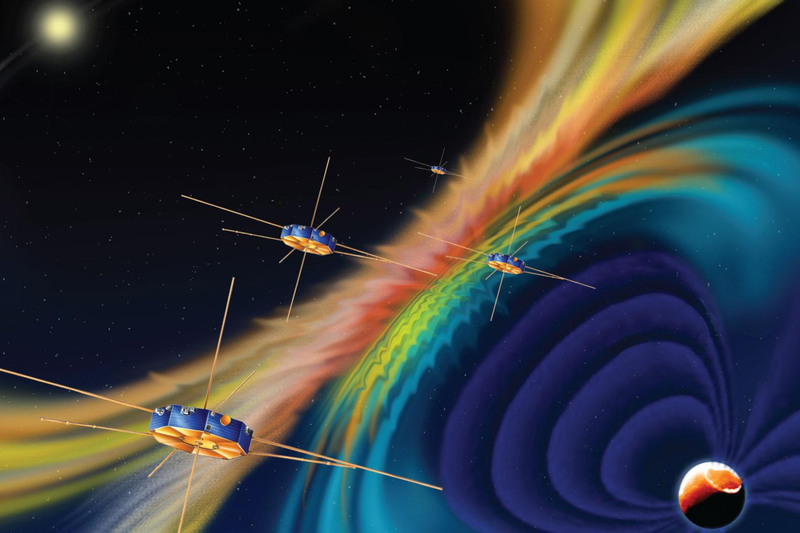April 7, 2016 report
Multi-satellite mission directly observes electron acceleration by fast-moving electric-field waves

(Phys.org)—An international team of researchers working on a project that involves monitoring and studying data received from a group of satellites that has been stationed very close to one another in orbit, has observed for the first time, electrons moving faster due to interactions with certain speedy electric-field waves, which suggests the possibility of such waves playing a role in the creation of high-energy particles. In their paper published in the journal Physical Review Letters, the team describes their observational data regarding a collision between the solar wind and a time domain structure and the impact it had on high energy electrons.
One area of research for astrophysicists involves studying what happens when the solar wind collides with the magnetic field that surrounds many planets and stars (an area called the magnetopause). Scientists are eager to learn as much as possible about the solar wind as it may one day be used as a resources for pushing future craft into the far realms of space. In this new effort, the researchers were part of a team working on the Magnetospheric Multiscale mission—where four satellites were sent into orbit circling the planet in a tight tetrahedral formation as their sensors measure magnetic and electric fields along with ions and electrons. Of specific interest was what happens when the solar wind and the Earth's magnetic field run directly opposite of one another, in a region known as the X-line.
The researchers report that the satellite group passed the X-line at one point late year, on the dayside of the magnetopause and into a section of a wave known as a time domain structure (TDS)—they have been observed many times before, but this time, because of the short distance between the satellites (approximately 10 km) the researchers could track the speed of the TDS, which allowed them to see an acceleration of as much as 50 percent in the speed of high energy electrons after the wave had moved on. These measurements confirm the theory that the TDS was able to cause particles to speed up, a finding which could have implications for engineers designing sensitive equipment for satellites, or perhaps even high flying aircraft.
More information: F. S. Mozer et al. Magnetospheric Multiscale Satellite Observations of Parallel Electron Acceleration in Magnetic Field Reconnection by Fermi Reflection from Time Domain Structures, Physical Review Letters (2016). DOI: 10.1103/PhysRevLett.116.145101
ABSTRACT
The same time domain structures (TDS) have been observed on two Magnetospheric Multiscale Satellites near Earth's dayside magnetopause. These TDS, traveling away from the X line along the magnetic field at 4000 km/s, accelerated field-aligned ∼5 eV electrons to ∼200 eV by a single Fermi reflection of the electrons by these overtaking barriers. Additionally, the TDS contained both positive and negative potentials, so they were a mixture of electron holes and double layers. They evolve in ∼10 km of space or 7 ms of time and their spatial scale size is 10–20 km, which is much larger than the electron gyroradius (<1 km) or the electron inertial length (4 km at the observation point, less nearer the X line).
Journal information: Physical Review Letters
© 2016 Phys.org




















